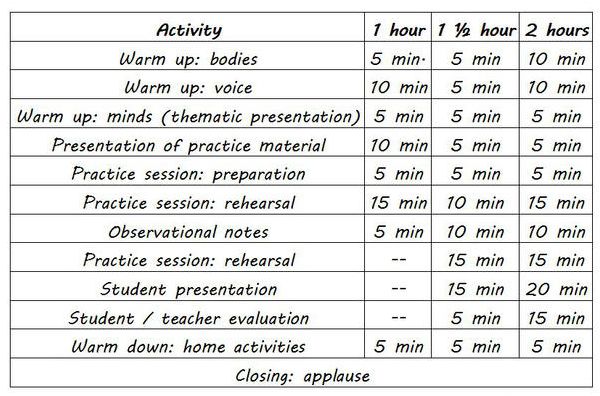
That chart above is not the definitive class structure; it is the class structure that I used in Interpretive ESL classes. It is not the end-all of class structures, it’s simply how I best organized my work in these classes. The time spent on each activity varied according to the overall length of the class. I’ve given examples for the three most common class lengths, 1, 1.5 and 2 hour sessions. Sessions of longer periods of time were cut in half and structure would more or less begin from zero in the second half.
Naturally, the actual time spent was totally relative to the activity involved. Sometimes warming up the body was a quick stretch lasting only a couple of minutes because the thematic presentation needed a couple of extra minutes. Sometimes the vocal warm up was a song and everyone was having such a good time with it that it overran its allotted time slot.
What was important for both myself and my students was the knowledge that all of the classes would more or less follow this structure. The hard part was over, we all knew just what to expect in every moment, there were no procedural surprises to deal with, we could concentrate on the material on hand.
Don’t copy my structure
I don’t mean that, of course you can copy my structure. It isn’t even mine. As I explained in another post, all those dance classes were structured in exactly the same fashion. The content changed from class to class as we learned, developed and improved. But, we always knew just what to expect when Ms Pratt entered the studio.
Ms Pratt was not the only teacher to demonstrate the importance of a strong structure behind the teacher’s planning. Ms Canny also believed in reusing structure, plugging material into a pre-planned presentation. At the beginning of the course in voice or direction or movement, Ms Canny handed out a calendar to each student with all the themes outlined from the very first day. Hardly any surprises there and lots of opportunity for students to take the initiative and be more prepared for the next class or classes.
Make a structure of your own, one you are comfortable with, one your students can depend upon. Use charts and be general in your activity names, general enough that in the second column you can concentrate on the detail that will fill in that activity, be it a warm up activity or a grammatical explanation or a bit of homework.
Further reading: Basic Class Structure: The Space
